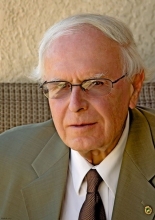CEE Seminar: Distinguished Presenter Zdenek Bazant, NAS & NAE Inductee

Distinguished McCormick Institute Professor
W.P. Murphy Professor of Civil and Mechanical Engineering and Materials Science
Northwestern University, Department of Civil & Environmental Engineering
Topic: Scaling of Quasibrittle Failure Probability & Fishnet Statistics for Nacreous Lamellar Structures
Abstract: The size effect on structural strength and its probability distribution function (pdf) is a complex problem for quasibrittle materials because their failure behavior transits from quasi-plastic at small sizes to brittle at large sizes. These are heterogeneous materials with brittle constituents in which the size of inhomogeneity, or representative volume element (RVE), is not negligible compared to the structure size. Aside from concrete, the archetypical example, they include fiber composites, coarse-grained ceramics, rocks, sea ice, snow slabs, wood, bone, foam, stiff soil, dry snow, carton, etc., and on the micro- or nano-scale, all brittle materials become quasibritle. Since the break probability is known exactly only for interatomic bonds (being equal to frequency), Kramer’s rule of transition rate theory is applied to nano-crack jumps. Based on proving the rules of multiscale transition of tail probabilities of break-to-material scale, the probability distribution function (pdf) of strength of one macro-scale representative volume element (RVE) is shown to have a Weibullian tail, calibrated to reach to probability circa 0.001, the rest being Gaussian. On the structure scale, only Type 1 failure is considered, i.e., the structure fails as soon as the first RVE fails. Hence, the weakest-link model applies on the structure scale. But, crucially, the number of links is finite, because of non-negligible RVE. For increasing structure size, the Weibullian portion gradually spreads into the Gaussian core. Only in the infinite size limit, the distribution becomes purely Weibull, but, importantly, with a zero threshold. Based on an atomistic derivation of the power law for subcritical macro-crack growth, a similar Gauss-Weibull transition is shown to apply to structure lifetime. The theory is then extended to the size dependence of Paris law and Basquin law for fatigue fracture, to statistics of fatigue lifetime and to residual strength after a period of preload. The theory is shown to match the existing experimental results on the monotonic strength, residual strength after preload, static and fatigue crack growth rates and static and fatigue lifetimes, including their distributions and size effects on the distributions. There are three essential consequences: 1) The safety factors must depend on structure size and shape; 2) To predict the pdf of strength, the size effect tests of mean strength suffice; 3) To predict the static and fatigue lifetimes, it suffices to add tests of initial subcritical crack growth rate. An interesting mathematical analogy predicting the lifetime of new nano-scale high-k dielectrics is also pointed out. Finally, a new “fishnet” statistics for strength of biomimetic nacre-like lamellar structures, modelled as a square fishnet pulled diagonally, is presented. This simple model differs from the weakest-link model as well as the fiber bundle model. The pdf is found again to transit from Gaussian to Weibullian, but in a different way.
Bio: Born and educated in Prague (Ph.D. 1963), Bažant joined the faculty at Northwestern University in 1969. At Northwestern, Bažant has been the W.P. Murphy Professor since 1990, the McCormick Institute Professor since 2002 and was the director of the Center for Geomaterials from 1981-87. He is an inducted member of the National Academy of Sciences, National Academy of Engineering, American Academy of Arts and Sciences, Royal Society of London, the academies of Italy (lincei), Austria, Spain, Czech Republic and Lombardy; Academia Europaea, and Europian Academy of of Sciences and Arts. He is an honorary member of the ASCE, ASME, ACI, RILEM. He has received seven honorary doctorates (Prague, Karlsruhe, Colorado, Milan, Lyon, Vienna, Ohio State); the Austrian Cross of Honor for Science and Art 1st Class from President of Austria; ASME Timoshenko, Nadai and Warner Medals; ASCE von Karman, Newmark, Biot, Mindlin and Croes Medals and Lifetime Achievement Award; SES Prager Medal; RILEM L’Hermite Medal; Exner Medal (Austria); and Torroja Medal (Madrid). He has authored seven books: Scaling of Structural Strength, Inelastic Analysis, Fracture & Size Effect, Stability of Structures, Concrete at High Temperatures, Concrete Creep and Probabilistic Quasibrittle Srength. H-index: 112, citations: 55,000 (on Google Jan. 2017, incl. self-cit.), i10 index: 550. In 2015, ASCE established the ZP Bažant Medal for Failure and Damage Prevention. He is one of the original top 100 ISI Highly Cited Scientists in Engineering. (www.ISIhighlycited.com). His 1959 mass-produced patent of safety ski binding is exhibited in the New England Ski Museum. For more info, visit http://cee.northwestern.edu/people/bazant/
Share
Upcoming Events
-
MAE 298 SEMINAR: Origins of Strengthening in Complex Metal Alloys from Full-scale MD Simulations
-
CBE 298 Seminar: Conductive and Tough Bioadhesive Hydrogel for Tissue Engineering and Biosensing
-
Annual Design Review 2025
-
CBE 298 Seminar: The Role of Carbon Removal in Achieving Net-Zero Greenhouse Gas Emissions
-
MSE 298 SEMINAR: Toward Predictive Materials Synthesis with Atomistic Simulations and Robust Machine Learning
